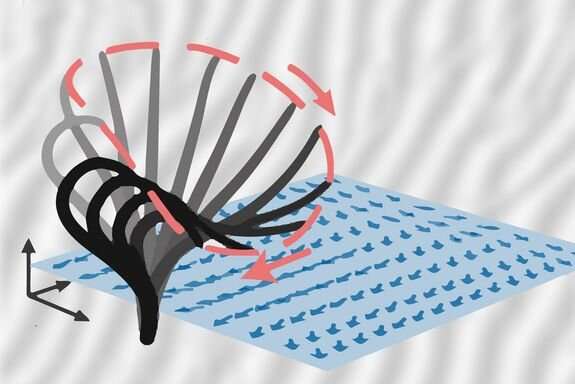Physical theory describes movements of micro-hairs

They are only very simple structures, but without them we could not survive: Countless tiny hairs (cilia) are found on the outer wall of some cells, for example in our lungs or in our brain. When these micrometer-sized hairs coordinate their movement and produce wave-like movements together, they can cause currents on a microscale and thus pump fluid from one place to another. Paramecia—unicellular organisms with numerous cilia—also use such effects to move around.
How the synchronization of such micro-hairs comes about and what effects it has are questions that have so far only been studied in large computer simulations. However, more than a few thousand hairs cannot be simulated in this way. Sebastian Fürthauer from TU Wien has now taken a completely different approach: Together with research teams from the U.S., he has developed a continuum theory of micro-hairs. This makes it possible to investigate questions that were previously completely out of reach. The theory has now been published in the journal PNAS.
Micro-world and macro-world
"The complicated connection between the micro-world and the macro-world plays an important role in many areas of physics," says Sebastian Fürthauer. Every air flow, every flow in a liquid can be understood as the movement of small particles—of atoms and molecules. It is possible to study the forces that act between the individual particles, how they collide and move together.
But it is also possible to disregard this view on the level of individual particles completely and look at things differently—using concepts like pressure, density and mean flow velocity. "In fluid mechanics, that's exactly what you do," says Sebastian Fürthauer. "You don't care about the fact that every flow consists of individual particles, instead you look for mathematical equations that use terms like pressure or density to describe the entire flow in a continuous way."
Collective waves instead of individual hairs
Fürthauer, who worked at the Flatiron Institute in New York before moving to TU Wien in February 2022, now applied precisely this approach to the physics of cells and their micro-hairs: Here, too, you can look at each hair individually, model their interaction mathematically, and then analyze with enormous computational and energy expenditure on supercomputers which collective movements and fluid flows arise as a result. However, one can also choose a continuous approach—similar to fluid mechanics—and describe the totality of the hairs mathematically.
In this way, you can find equations that explain not individual hairs, but the wave movements of many hairs. "You can see very exciting effects here," says Sebastian Fürthauer. "For example, you can consider what happens when the hairs simply move at random. And you realize that this state is unstable. The purely random movement of hairs cannot remain permanent because the hairs inevitably influence each other. This leads to a synchronization, a formation of collective waves, all by itself."
But even the opposite of purely random movement—namely perfect unison—proves to be unstable: according to Fürthauer's continuum equations, the interaction between hairs and surrounding fluid leads to very specific patterns of movement that ultimately enable fluid transport—exactly as can actually be observed in the experiment.
Only asymmetry allows movement
This process is anything but trivial: on the micro-scale, fluids behave quite differently than we are used to. When you swim in water, you can move your arms and legs back and forth in such a way that the overall swimming movement is forward. On a micro scale, however, it is different—for a micro-hair, the liquid behaves much more viscously, like thick honey. When a hair moves in a circle, it can push fluid back and forth, but this action is symmetrical—the force that is first exerted in one direction is then also exerted in the other direction, the bottom line is that everything is the same at the end as it was at the beginning, and nothing has moved.
"Only when this symmetry is broken can a macroscopic movement, such as pumping fluid in one direction, take place at all," explains Sebastian Fürthauer. "And it is precisely this symmetry breaking that occurs when the hairs coordinate their movement and form waves."
Cells and jumbo jets
"If you analyze the structures completely on the computer, you might be able to simulate a few thousand hairs—for a biological system, that's still quite few," says Sebastian Fürthauer. "With our continuum method, the number of hairs doesn't matter; we describe them collectively, regardless of whether there are ten thousand or a million."
Sebastian Fürthauer is confident that the new theory can be used to investigate phenomena that could not previously be studied on the level of individual hairs: "If you want to calculate the flight behavior of a jumbo jet on a computer, no one would think of simulating each molecule of air individually. You use continuum equations to describe the air flow. This is exactly what we are now doing with cells and tissues."
More information: Anup V. Kanale et al, Spontaneous phase coordination and fluid pumping in model ciliary carpets, Proceedings of the National Academy of Sciences (2022). DOI: 10.1073/pnas.2214413119
Journal information: Proceedings of the National Academy of Sciences
Provided by Vienna University of Technology





















